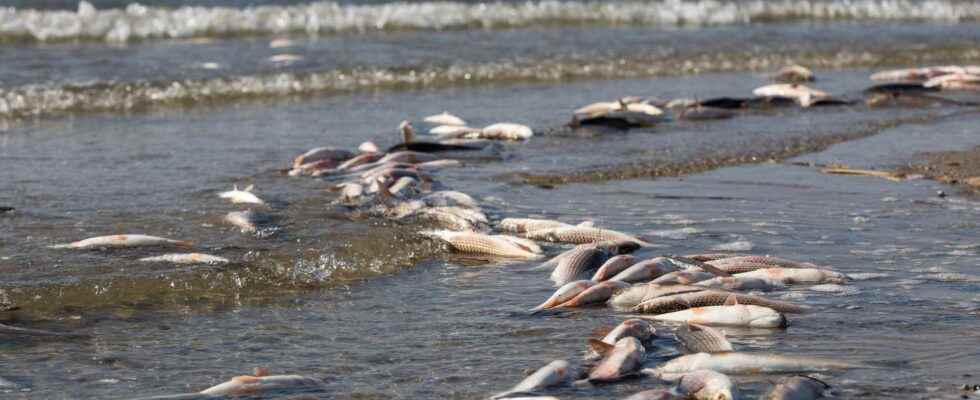Among the effects of global warming is the deoxygenation of the oceans. An effect that researchers have tried to quantify. According to them, by 2080, no less than 70% of our oceans could lack oxygen. And a lot of fish with them…
For a long time, scientists have known that with the climate change, the oceans are losing their ability to transport dissolved oxygen. Oxygen that aquatic animals need to live. But Shanghai University researchers (China) are now presenting new worrying results. According to them, by 2080, about 70% of the world’s oceans could lack oxygen. With a major impact on fisheries.
To predict how and when deoxygenation — read, the reduction of dissolved oxygen in the waters — of the oceans will occur, the researchers worked on climate models. On a scenario ofemissions high and another of low emissions. The researchers divided the oceans into three subsets: the deep ocean, the middle ocean, and the shallow ocean. They then modeled when the loss of oxygen in the water exceeds natural fluctuations in oxygen levels.
The researchers note that deoxygenation “significant and potentially irreversible” started to occur in 2021 at medium depths. Whatever the scenario, this area is the one that loses its oxygen the fastest. But the process begins 20 years later with the low emission scenario. A proof that the reduction of carbon dioxide emissions (CO2) and others greenhouse gas could help delay the degradation of global marine environments. Although the researchers acknowledge that it is unclear at present whether dissolved oxygen would return to pre-industrial levels.
Consequences for us
It should be noted that the average depths – the so-called mesopelagic zones, between approximately 200 and 1,000 meters – are precisely those which shelter the mostspecies commercially fished around the world. If the oxygen concentration in these areas of the ocean drops, we can fear both environmental disturbances, seafood shortages and economic hardship for the people living off of it.
The problem is that if this mesopelagic zone is the most important to our eyes of humans, it is also the most sensitive to the problem of deoxygenation. It is, in fact, not enriched in oxygen by the atmosphere and photosynthesis as the surface of the ocean can be. It also suffers from accelerated decomposition of algae, a process that consumes oxygen.
The researchers also point to the fact that the oceans closer to the poles – the western and northern Pacific and the southern oceans – are particularly vulnerable to deoxygenation. Perhaps a consequence of the accelerated warming of these regions. Oxygen minimum zones, zones of tropics known to have low levels of dissolved oxygen, also appear to be extending to areas of higher latitudes.
The oceans are suffocating because of our CO emissions2
When the CO level2 increases in the atmosphere, the oxygen content decreases in the oceans. And researchers warn us today: we are only at the very beginning of this global deoxygenation. Even if we managed to stop our CO emissions2it would still continue for several centuries.
Article of Nathalie Mayer published on 04/26/2021
Our CO emissions2 gradually raise the temperature Earth. But they have another effect, perhaps less visible still. They largely contribute to the deoxygenation of our oceans, by reducing the water solubility of gases in general and of oxygen in particular. And by slowing down ocean circulation and vertical mixing. Over the past fifty years, our oceans have lost about 2% of their oxygen.
Today, some researchers from Helmholtz Center for Ocean Research Kiel (Germany) report that less than a quarter of ocean deoxygenation, which will ultimately be caused by our historic CO2, has already taken place. In other words, even if we stopped our broadcasts right now, the oxygen concentrations in our oceans will continue to decline for centuries to come. “To achieve more than four times what we have recorded so far”, specifies Andreas Oschlies, researcher, in a press release. The deep ocean should thus lose more than 10% of its pre-industrial oxygen content.
The depths more permanently affected
The researchers note that, over the long term, deoxygenation takes place mainly — 80%, they say — in the deeper layers of the oceans. Because a slower circulation increases water residence times and the build-up of respiratory oxygen demand. With an impact on ecosystems up to 25% loss of life, especially in the high seas — below 2,000 meters. An environment which, until then, was considered by oceanographers to be particularly stable.
The upper layers of the ocean are more sensitive to warming. Bad news and good news at the same time. Bad because they are therefore already suffering from an expansion of oxygen minimum zones. Good because this expansion can be stopped in a few years if our CO emissions2 are also stopped. A climate action rapid and ambitious could therefore save at least the ecosystems close to the surface.
Interested in what you just read?
